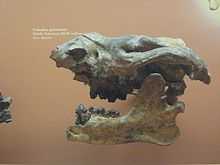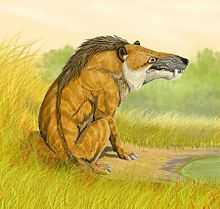Triisodontidae
| Triisodontids Temporal range: Early Paleocene to Late Eocene | |
|---|---|
 | |
| Triisodon quivirensis | |
| Scientific classification | |
| Kingdom: | Animalia |
| Phylum: | Chordata |
| Class: | Mammalia |
| Order: | †Mesonychia |
| Family: | †Triisodontidae Trouessart, 1904 |
| Type genus | |
| Triisodon | |
| Genera | |
|
†?Andrewsarchus | |

Triisodontidae (literally "three equal teeth") is an extinct family of mesonychian placental mammals. Most triisodontid genera lived during the early Paleocene in North America, but the genus Andrewsarchus (if it is a mesonychian, and not an artiodactyl) is known from the late Eocene of Asia.[1] Triisodontids were the first relatively large predatory mammals to appear in North America following the extinction of the dinosaurs.[2] They differ from other mesonychian families in having less highly modified teeth.[3]
Because of their comparatively simpler teeth, the Triisodontids are regarded as basal mesonychids. Some experts regard the triisodontids as being condylarths, or even arctocyonids, rather than mesonychids proper.
References
- ↑ McKenna, M. C, and S. K. Bell (1997). Classification of Mammals Above the Species Level. Columbia University Press. ISBN 0-231-11012-X.
- ↑ Clemens, W.A. and T.E. Williamson (2005). "A new species of Eoconodon (Triisodontidae, Mammalia) from the San Juan Basin, New Mexico". Journal of Vertebrate Paleontology 25 (1): 208–213. doi:10.1671/0272-4634(2005)025[0208:ANSOET]2.0.CO;2. ISSN 0272-4634.
- ↑ Matthew, W.D. (1937). "Paleocene faunas of the San Juan Basin, New Mexico". Transactions of the American Philosophical Society (American Philosophical Society) 30: 1–510. doi:10.2307/1005521. JSTOR 1005521.